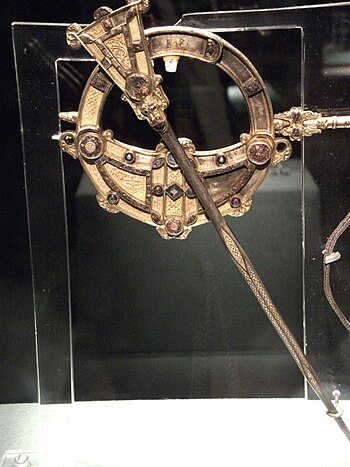So last time we were discussing a particular set of authors, who were describing the structure of a Wire Woven Silver Scourge. They also listed several other artifacts. I raised the questions: Were they consistent in the use of the word Trichinopoly? And is ANY of this significant anyway?
As many college advisers in graduate school will tell you, it is important to find the original sources for the referenced chains. Not the articles that reference the discovery, but the actual reports with line drawings and pictures. Or, better yet, current high quality pictures of the artifacts themselves. The farther that you are from the original source of information the more likely that mistakes have entered into the record. In the ensuing 140 years since the finds, England has been involved in two major World Wars including the second World War which is known to have destroyed many items. It is possible that some of these pieces may have vanished or been destroyed.
The first artifact that the author mentioned was the Tara Brooch. I checked all of my research books looking for a picture that was good enough to discern which form of wire weaving was used. No luck.
I went online. The Tara Brooch is held by the National Museum of Ireland. They show poor quality pictures that focus completely on the elaborate gold work of the brooch. The chain on the brooch looks like a rat’s tail in most of the pictures – just a dark silhouette with almost no detail. I had always thought it was done in the Nahlbinding style of wire weaving, but I have no good proof.
The Great Hoard from Croy was next on my list. According to the Royal Commission on the Ancient and Historical Monuments of Scotland, this hoard was located in 1875 and 1876. The first portion of the hoard is described as containing ” part of a band of knitted silver wire”, and all of the hoard is held by the National Museum of Antiquities of Scotland. J A Graham-Campbell’s main concern was whether the chain is of Scandinavian origin or not. He states, “The chain is manufactured in the Trichinopoly technique (Wilson and Blunt 1961, 93) and represents the possible Norse element in this hoard since similar chains have been found in the hoard from Cuerdale, Lancashire (Hawkins 1847, fig 84), deposited c AD 903, in the hoard from Skaill, Orkney (VA II, fig 60), deposited c AD 950, in the 9th-century Ballinaby grave 2, Islay (VA II, fig 18), and in the Inchkenneth hoard, deposited c AD1000; but the presence of such a chain, in the form of a scourge, in the hoard from Trewhiddle, Cornwall (Wilson and Blunt 1961, 84, 92-3, pixxvi, a), deposited c AD 875, raises the possibility that such chains found in insular contexts might be of Anglo-Saxon manufacture.”
The class teacher at Gulf War did not have a handout. We were permitted to use our phones to copy some not-great-photos of pictures of some of these pieces. The big problem is that all of the pictures are reproduced from drawings that were made of the pieces in the 1800’s. Are they accurate, or not? If they are accurate it appears that the chain from Inch Kenneth, Ballinaby, Skaill, Croy, and Garron Point are all made in the “Anglo- Saxon” fashion (knit rather than Nahlbinding).
But what if they are not accurate, or are inconsistent in their accuracy? I did try to locate the actual pieces of the hoards. The Cuerdale Hoard went to more than 170 locations including the British Museum, the Ashmolean Museum, and the National Museums in Liverpool. I viewed all 184 of the pictures of the Cuerdale Hoard that were available from the British Museum. It was all hack silver, bar stock and bracelets. A review of the Cuerdale pieces at the Ashmolean revealed about 40 pieces of silver – all hack silver, bar stock and bracelets. The National Museums, Liverpool are in the process of digitizing their artifacts and have nothing useful about the Cuerdale hoard online except a discussion of the over 800 coins from this hoard that they have in their numismatic collection. Dead End!
I finally found a picture of the chain from the Great Hoard of Croy online. The description states that it is made in the Trichinopoly technique using a continuous wire. I have to admit, it does look to be knit, but the resolution of the picture is just NOT good enough to be certain.
But is any of this significant? I guess we will have to talk about that next time!
English: Tara Brooch (Photo credit: Wikipedia)

